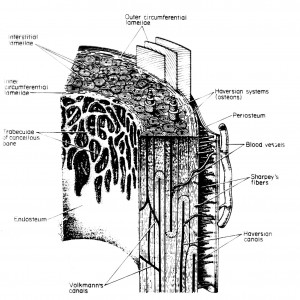Definition of Periosteum
It is a dense fibrous membrane made up of irregular connective tissue that covers the external surface of the bones. It is completely opposite to endosteum that lines the inner cavity of long bones. The tissue, however, does not line the joints of long bones and is replaced with a cartilage, which prevents bones from rubbing together. The sites for attachment of ligaments and tendons are also devoid of this membrane. In Greek, the term “Periosteum” refers to surrounding bone.
Periosteum Location
Picture 1 – Periosteum Location
As aforementioned, the tissue is a protective membrane on the surface of bones.
Periosteum Origin
It arises from condensed mesenchymal connective tissue during fetal development and is continuous with the specialized fibers that insert into the bone.
Periosteum Description
It mainly comprises of the following two layers:
- Outer fibrous layer: It is composed of collagen-producing cells called fibroblasts and contains nerve fibers that cause pain when damaged due to the presence of nociceptive nerve endings. It also has a rich supply of blood vessels and branches, which pierces the bone to supply the osteocytes or bone cells. These perpendicular branches pass into the bone along Volkmann canals to the vessels in the Haversian canals, central channels in the middle of compact bones.
- Inner cellular/ Cambium layer: It comprises of progenitor cells that give rise to osteoblasts, which are the bone-making cells. Strong collagenous fibers from the cambium penetrate the underlying bone along with blood vessels to form Sharpey fibers in order to undergo binding. In fact, these perforating fibers extend to the outer circumferential and interstitial lamellae.
The membrane is modified to some extent on the inner surface of the skull as pericranium that joins the dura mater, the outermost and most fibrous of the three membranes covering the brain as well as the spinal cord.
Functions of Periosteum
The specialized fibroblasts of the cambium layer are responsible for the development of new bones in fetal life and early childhood as well as increasing the width of long bones. Constant remodeling of bone throughout life in adults is chiefly attributed to this membrane. In case of a bone fracture or severe injury, osteoblasts, and chondroblasts, the cartilage cells, erupt from progenitor cells. These special types of fibroblasts undergo proliferation as well as differentiation to form new and healthy bones. The membrane is a great source of nourishment for the bones, owing to the supply of numerous blood vessels.
Periosteum Disorders
A subperiosteal abscess, between the membrane and mastoid bone, may develop as a complication in patients with mastoiditis, a condition marked by inflammation of the mastoid process and mastoid cells due to a bacterial infection. Injury from direct trauma to a bone or overuse of a particular body part results in periostitis in which the membrane undergoes inflammation causing severe pain. Athletes and regular runners are often prone to this condition. Doctors often use a surgical elevator to lift damaged membrane from the bone.
Periosteum Pictures
Here are some of the pictures of Periosteum for a better understanding of its location.

Picture 2 – Periosteum

Picture 3 – Periosteum Photo
References
http://en.wikipedia.org/wiki/
http://www.nlm.nih.gov/


No comments yet.